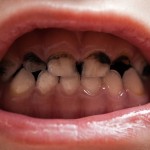
Childhood caries is one of the most common chronic diseases worldwide. Reviews and clinical trials of silver diamine fluoride (SDF) have provided evidence supporting its efficacy and its use is increasing. A number of commercial agents are now available and in use by dentists containing different concentration of SDF (12%, 30%, and 38%). However, information about the effectiveness of different application frequencies and concentrations of SDF is limited.
The aim of this trial was to compare the efficacy of two commercially available SDF solutions at concentrations of 38% and 12% in arresting caries in primary teeth when applied at yearly or half-yearly intervals over 36 months.
Methods
Children aged 3-4 yrs with at least 1 soft carious lesion were recruited from 37 kindergartens in Hong Kong. Eligible children were randomised in to 1 of 4 groups. Before randomization, the children were put into 2 strata according to the number of carious tooth surfaces they had (1 to 3 surfaces and >3 surfaces) to achieve balance of the disease severity among groups.
- Group 1: 12% SDF applied every 12 months
- Group 2: 12% SDF applied every 6 months
- Group 3: 38% SDF applied every 12 months
- Group 4: 38% SDF applied every 6 months
Children were examined at baseline and at 6 monthly intervals by the same examiner. Plaque score and caries experience and lesion activity was measured. A lesion was regarded as active if it was soft on probing and arrested if its surface was smooth and hard on probing.
Results
- 888 children (519 boys, 369 girls) with 222 study children in each treatment group were recruited.
- At baseline the number of active caries lesions in groups 1, 2, 3, and 4 was 1,051, 1,072, 1,073 and 1,024, respectively.
- At the 30-month examination
- 799 children (465 boys, 58.2%) with 3,790 lesions were evaluated
- Dropout rates were 12%, 9%, 9%, and 12% in groups 1, 2, 3, and 4, respectively
- The mean (SD) numbers of tooth surfaces with arrested caries were 2.59 (2.94), 2.85 (2.91), 3.20 (3.71), and 3.49 (3.27) for groups 1, 2, 3 and 4, respectively
- At surface level, the caries arrest rates for groups 1, 2, 3, and 4 were 55.2%, 58.6%, 66.9%, and 75.7%, respectively.
- Lesions treated with 38% SDF had a higher chance to become arrested than those treated with 12% SDF (odds ratio [OR], 1.98; 95% confidence interval [CI], 1.51–2.60).
- There was a statistically significant interaction between 30-month visible plaque index (VPI) and caries arrest rate with a lower chance of caries arresting in those with a high VPI.
Conclusions
The authors concluded: –
Based on the 30-month results of this study, 38% SDF solution is more effective in arresting dentine caries of primary teeth among preschool children compared to 12% SDF. Interaction between frequency of SDF application and oral hygiene status can be significant. Children’s oral hygiene should be taken into account when choosing the periodicity of SDF application. In children with poor oral hygiene, semi-annual application of SDF is more effective than annual application in arresting dentine caries.
Comments
This well-conducted RCT found that 38% SDF was more effective than 12% SDF in arresting caries in primary teeth. However, in interpreting the results it should be noted that all four groups received an active agent and the water supply in Hong Kong is fluoridated at 0.5ppm.
38% SDF provided a 66.9% caries arrest rate for an annual application compared with 75.7% for a semi-annual application. The findings also suggest that children with poorer oral hygiene would benefit from a biannual application as high visible plaque levels were seen to reduce effectiveness of SDF. The findings are in line with other studies on SDF and while the effectiveness of SDF is high the black staining of arrested lesions remains a potential drawback to its wider acceptance.
Links
Primary paper
Fung MHT, Duangthip D, Wong MCM, Lo ECM, Chu CH. Randomized Clinical Trial of 12% and 38% Silver Diamine Fluoride Treatment. J Dent Res. 2017 Aug 1:22034517728496. doi: 10.1177/0022034517728496. [Epub ahead of print] PubMed PMID: 28846469.
Other references
Dental Elf – 22nd Aug 2016

Are there dentists in the UK who provide SDF treatment for children?
I believe that any silver diamine products are currently licensed for caries prevention in the UK. Is use is underconsderation by some in some cases. .